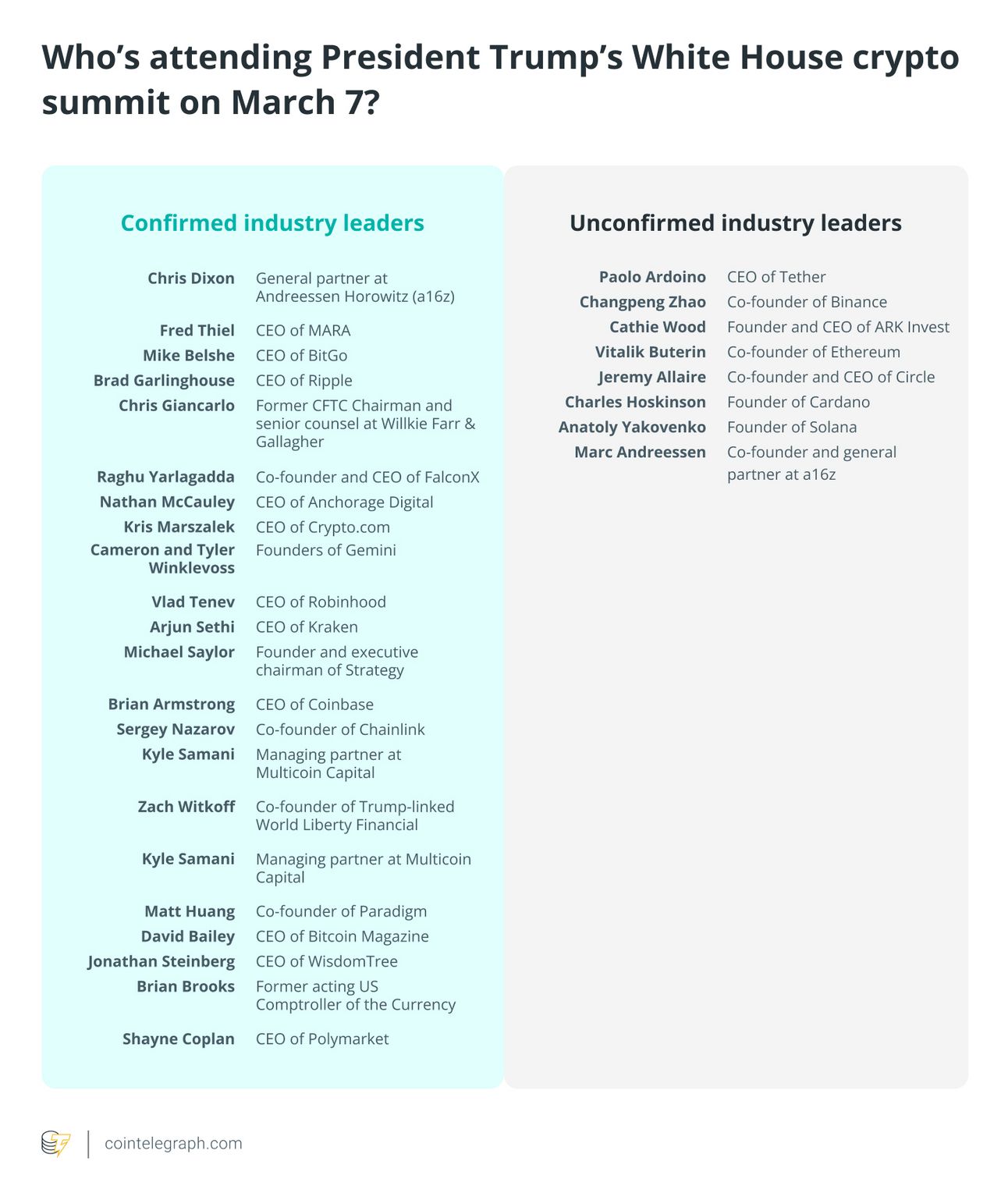- Block Green Industry Weekly
- Posts
- Crypto Industry Gathers at White House to Discuss U.S. Digital Asset Strategy
Crypto Industry Gathers at White House to Discuss U.S. Digital Asset Strategy
PLUS Miner February updates and reports

🏦 Industry Leaders Seek Clarity on Trump’s Crypto Reserve and Regulatory Vision
Today, top crypto industry leaders will meet with U.S. President Donald Trump at the White House to discuss his vision of making the U.S. the "crypto capital of the world." The summit will focus on the strategic reserve and notable attendees include Michael Saylor, Vlad Tenev (Robinhood), and Brian Armstrong, among others.
The industry is eager for more details on the proposed strategic reserve and clearer regulatory guidance. While some, like Brian Armstrong, support a BTC-only reserve, others, such as JP Richardson, raise concerns about including smaller, more volatile cryptocurrencies in the mix, fearing it could introduce unnecessary risk.
Despite some concerns about potential conflicts of interest, with Trump’s family involved in the crypto space, there is optimism about the future of the industry under this administration. The summit also aims to address issues of regulation and provide clearer guidelines for the sector.
🏈 White House Crypto Summit Kicks Off
Happening today, the White House Crypto Summit gathers industry leaders after Trump’s order to create a Bitcoin reserve. Some hail it as historic, others doubt its impact, while critics call it a profit play.

⛏️ In The News
Core Scientific shares fell 18% after reports that Microsoft scaled back its CoreWeave deal over missed deadlines, though CoreWeave denied contract cancellations.
US Customs may have mistakenly seized thousands of Bitcoin miners, thinking they were radio frequency devices, before recently releasing them, while industry players seek clarity on the situation.
El Salvador will continue buying at least one BTC per day despite IMF pressure to halt purchases, with President Nayib Bukele reaffirming the country's commitment to its Bitcoin strategy.
Belarus President Alexander Lukashenko has ordered the development of crypto mining using the country’s excess electricity, inspired by the U.S.'s push for a national crypto reserve.
📆 Miner February Update
🏃 MARA
In February 2025, MARA increased its daily BTC production by 4% compared to January, producing 25.2 BTC per day, up from 24.2 BTC.
MARAPool won 206 blocks in February, reflecting a 6% decrease from the 218 blocks won in January. BTC production for February was 706 BTC, a 6% decrease from January’s production of 750 BTC.
The company’s energized hashrate slightly improved by 1%, reaching 53.7 EH/s, compared to 53.2 EH/s in January.
MARA is nearing the completion of a 40 MW data center in Ohio, where it plans to install over ten thousand S21 Pro immersion miners.
MARA is expanding into AI and adjacent markets, investing in research and development to create additional long-term revenue opportunities.
🧼 CleanSpark
CleanSpark increased its Bitcoin treasury by 6% in February, mining 624 BTC worth over $55m.
The company sold 2.73 BTC at an average price above $95,000 per BTC and now holds 11,177 BTC. With holdings worth over $1b, CleanSpark has the fifth-largest corporate Bitcoin treasury.
In Q1 FY2025, CleanSpark’s revenue surged 120% year-over-year to $162.3m, with profits rising to $241.7m from $25.9m the previous year.
👮 Riot
In February 2025, Riot Platforms produced 470 BTC, a decrease of 11% from 527 BTC produced in January. The average BTC/day was 16.8 BTC, slightly down by 1% from the 17.0 BTC produced per day in January.
The company held 18,692 BTC by the end of February, a 3% increase from January’s 18,221 BTC and a 132% increase from February 2024. Riot did not sell any BTC in February, and no net proceeds or sales data were reported.
The deployed hashrate across Riot’s operations remained stable at 33.6 EH/s, with no significant change from January.
The operating hashrate at the Rockdale facility improved by 2%, reaching 12.9 EH/s, while the Corsicana facility saw a 2% decrease to 13.9 EH/s.
The average operating hashrate across all facilities increased by 0%, totaling 29.4 EH/s, up from 29.3 EH/s in January.
Riot earned $2.8m in total power credits in February, down 33% from January, but a 196% increase from February 2024.
Power costs at the Rockdale facility increased by 4%, while costs at the Corsicana and Kentucky facilities also saw minor increases.
CEO Jason Les highlighted the impact of planned maintenance, curtailment, and colder weather on production but noted operational efficiencies kept daily Bitcoin production declines minimal.
Riot continues to prioritize AI/HPC initiatives and sees strong market demand, especially at its Corsicana facility, which could access up to 1.0 GW of power by 2026.
🛖 Hut 8
BTC produced in February was 46 BTC, a decrease from 65 BTC in January.
The company holds 10,237 BTC in reserve, slightly up from 10,208 BTC in January.
The company’s total energy capacity under management remained steady at 665 MW.
Total hashrate under management dropped to 12.3 EH/s, from 12.7 EH/s in January. Deployed miners decreased to 109.2K, down from 115.3K in January.
Hut 8's managed services energy capacity remained at 280 MW, and deployed miners in this segment dropped to 84.4K.
Hut 8 secured 592 acres in Louisiana for its River Bend campus, part of a 430 MW AI data center development opportunity.
The Vega development is on schedule for Q2 energization, with miner deliveries for a 15 EH/s ASIC Colocation agreement underway.
ASIC fleet upgrades are ongoing, with new miners arriving at Salt Creek and Medicine Hat, while efficient miners are being relocated to Alpha to improve fleet performance.
🧑🔬 Core Scientific
In February 2025, Core Scientific earned 215 self-mined BTC, a decrease from 256 BTC in January. The average BTC earned per day from self-mining was 7.7, slightly down from 8.3 in January.
Core Scientific’s total energized hash rate was 19.4 EH/s at the end of February, a slight decrease from 19.5 EH/s in January.
The company’s self-mining energized hash rate was 18.4 EH/s, with 159,000 Bitcoin miners making up the majority of the fleet.
Hosting services accounted for approximately 1.0 EH/s from 7,000 customer-owned miners.
The average fleet efficiency for the self-mining operation was 24.4 J/TH, marginally lower than the 24.5 J/TH in January.
Core Scientific operated around 166,000 total Bitcoin miners across its self-mining and hosting operations by the end of February.
The company supported local grids by reducing its power consumption, delivering 50,373 MWh to the electrical grids.
👁️ IREN
In February 2025, IREN mined 459 BTC, down from 521 BTC in January. Overall revenue for February was $43.9m, down MoM from $52.0m.
The company’s average operating hash rate was 28.7 EH/s, a slight decrease from 29.0 EH/s in January.
Electricity costs per BTC increased to $28,341, up from $24,683 in January.
Hardware profit decreased to $30.9m, with a hardware profit margin of 70%, down from 75% in January.
IREN’s AI Cloud Services revenue increased to $1.2m, up 39% from January. AI Cloud Services hardware profit margin remained strong at 96%.
The company is ramping up to 50 EH/s over the next four months, which is expected to generate substantial operating cash flows.
IREN commenced site-works on the 1.4GW Sweetwater 1 project, on track for energization in April 2026.
The company is finalizing a 600MW connection agreement for the Sweetwater 2 project.
🧑🌾 Bitfarms
BTC production for February 2025 was 213 BTC, a 6% increase MoM. Daily average BTC earned was 7.6 BTC, equating to approximately $638,400 per day based on a BTC price of $84,000.
BTC sold amounted to 75 BTC for $6.5m, in line with treasury management practices. The company’s BTC treasury now holds 1,260 BTC, valued at $105.8m.
Operational hashrate increased 6% MoM, reaching 16.1 EH/s by February 28, 2025. Average operational hashrate grew 20% to 13.4 EH/s.
Energy capacity remained stable at 437 MW, including 256 MW from hydropower. Efficiency remained at 20 w/TH.
Strategic acquisitions and sales are on track: Bitfarms is set to close the acquisition of Stronghold Digital Mining and the sale of its 200 MW Yguazu site by Q1 2025.
🦘 Cango
In February, Cango produced 472.7 BTC, down from 538.2 in January.
The average number of BTC/day in February was 16.9, slightly lower than January’s 17.4.
Cango’s total BTC holdings increased to 1,944.7 from 1,472.0 in January.
No Bitcoins were sold in February.
The company’s deployed hashrate remained at 32 EH/s, with an average operating hashrate of 29.7 EH/s, down from 30.1 EH/s in January.
📆 Miner Reports
🛖 Hut8 Q4
Hut 8 reported Q4 2024 revenue of $31.7m, reflecting an 18.6% drop from the previous year. Full-year revenue saw significant growth, increasing by 69.2% to $162.4m compared to $96.0m in 2023.
Net income for Q4 surged to $152.0M, marking an astounding 1,333.3% increase year-over-year. Full-year net income hit $331.4M, up 1,414.6% from $21.9M in 2023, primarily driven by gains in digital assets.
Bitcoin mining output decreased significantly, with only 236 BTC mined in Q4, a 72.3% drop YoY. Overall, the company mined 1,466 BTC in 2024, down 47.5% YoY from 2,789 BTC in 2023.
Energy costs per MWh dropped by 30%, from $45.47 in Q4 2023 to $31.63 in Q4 2024, improving efficiency and operational costs.
The company’s total energy capacity under management increased by 21.2%, reaching 1,020 MW by the end of 2024, up from 842 MW the previous year. This was bolstered by a development pipeline of 12,300 MW, with 2,800 MW under exclusivity.
Hut 8’s strategic BTC reserve grew to 10,171 BTC, a 10.6% increase from 9,195 BTC in 2023, valued at $949.5m as of December 31, 2024.
Capital initiatives included converting a $37.9m loan to equity at a 51% premium, launching a $500m ATM program, and a $250M stock repurchase program, reinforcing the company's strong financial foundation.
The company further expanded its infrastructure with the launch of Highrise AI, marking a strategic entry into the AI cloud services space and strengthening its digital infrastructure capabilities.
Hut 8 completed a merger with USBTC in November 2023, positioning itself as a stronger player in the U.S. market, integrating both operations to drive future growth.
🦘 Cango Q4
Cango reported total Q4 2024 revenues of $91.5m, a significant increase from $18.0m in Q4 2023, primarily driven by the launch of its Bitcoin mining business.
The Bitcoin mining operation generated $89.5m in revenue, with the company mining a total of 933.8 BTC by the end of 2024.
Net income for Q4 2024 was $7.7m, a substantial recovery from the net loss of $14.3m in Q4 2023, showcasing a strong turnaround.
As of December 31, 2024, Cango’s cash and cash equivalents totaled $345.3m, with short-term investments amounting to $168.7m.
Cango reported full-year 2024 revenues of $110.2m, down from $229.7m in 2023, reflecting a decrease in automotive trading revenue, which was offset by Bitcoin mining revenue.
Revenue from Bitcoin mining for the full year was $89.5m, despite the business launching only in November 2024.
⛓️ DMG Q1
Revenue for Q1 2025 reached $11.6m, a 97% increase from Q4 2024 and a 20% increase from Q1 2024. BTC mined totaled 97 BTC in Q1 2025, up 49% from Q4 2024.
Despite increased revenue, net income fell by $10.1m to a net loss of $3.1m, largely due to unrealized gains on digital currency revaluation in Q1 2024.
Hashrate increased 65% sequentially to 1.62 EH/s and 68% year-over-year, with a target to reach 2.1 EH/s by March 2025.
Fleet efficiency improved 7% to 22.9 J/TH, with a target of 21 J/TH once hydro miners are fully energized.
Cash and digital assets totaled $58.2 million, up 62% from Q4 2024 and 110% from Q1 2024.
February saw 27 BTC mined, a slight decrease from 31 BTC in January, with an average hashrate of 1.81 EH/s excluding curtailment.
Bitcoin holdings at the end of February reached 443 BTC, up from 431 BTC in January 2025.
DMG sold 78 BTC for $7.3m, representing 81% of the mined BTC in Q1 2025.
Operating expenses rose, driven by higher utilities costs from expanded mining operations and increased general and administrative expenses, particularly interest expenses.